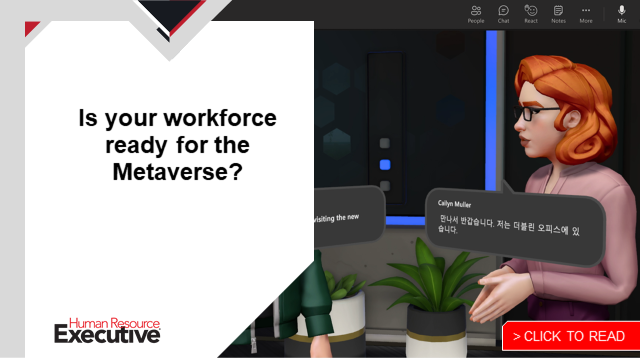In his first six months as CEO of learning and development platform provider Cornerstone OnDemand, Himanshu Palsule already has overseen two strategic purchases of leading L&D systems: EdCast and SumTotal Systems. HRE spoke with the affable Palsule to hear his thoughts on the state of the employee training industry, why upskilling will survive a recession, and how one client needed help with their hundreds—yes, hundreds—of talent management systems.
Here’s a lightly edited and condensed version of our conversation.
HRE: We’re seeing consolidation in the learning and development space, including Cornerstone’s two acquisitions this year. Can you give us the lay of the L&D land?

Himanshu Palsule: This is something that we spend a lot of time analyzing, especially pattern recognition of where this whole thing is headed. I completed six months this week and literally the first three or four months, I went out on a listening tour—six countries and about 75 customers—to really understand the nuance of learning management and skilling.
I’ve been in the HCM space for over 25 years but when you speak with chief learning officers and someone who manages L&D today, it’s so stark, the impact of skilling that they’re facing now. Even more so than three or five years ago.
HRE: How so?
Palsule: I think we’re at an inflection point of so many things that are happening: the extended supply chain challenges, the pandemic’s impact on remote access to information, the shortage of labor across everything and the halflife of skills.
Someone told me that every two and a half years, they need to reskill people, which [used to happen] every seven to eight years. Also, they now have a multi-generational workforce of three or four generations doing the same work and the way they learn differs.
HRE: Some economists predict that we’re heading toward a recession. If that’s true, will this change the balance of power in today’s employee-led environment?
Palsule: Let’s say we do get into a recessionary economy where there probably is a greater willingness for the workforce to come back to the workplace. At the same time, employers still will be facing the pinch of being able to recruit at scale. Large customers like Amazon, Walmart and Unilever would still need to be hiring hundreds if not thousands in a short amount of time.
The need to upskill their existing talent will be paramount in an up market or in a down market for those companies that made that investment.
 HRE: What skills are employees interested in? Is it hard skills like network and AI certification, or is it soft skills like leading with empathy?
HRE: What skills are employees interested in? Is it hard skills like network and AI certification, or is it soft skills like leading with empathy?
Palsule: It’s both. I visited Edwards Life Sciences and they manufacture these heart valves, which obviously are critical devices that require 300 stitches. Most of the workforce that comes in is unskilled. I was there for the 2:30 shift when they have to take a learning management course on their screen first. That’s why I was there. Once you pass it, the system opens up and they have the ability to go in and work. If they fail, they have to go upstairs to the third floor and take a three-hour reorientation and come back to be able to start their shift.
Now this workforce leaves every day and they’re paid a significant amount of money per hour. But you have no idea which one of them is going to come back to work the next day and you have to start all over again.
The need for skills and training in places like that and the demand for just training them on the job at the right time is so critical that they’re gonna have to find a way to solve for it in any economy.
HRE: As Cornerstone’s CEO, are you thinking of two to three acquisitions a year?
Palsule: I think I would like to get to a cadence of that nature. We obviously have to make sure we have the ability to scale. I think these two—EdCast and SumTotal Systems—will prove to us whether it’s going to be three or four a year or at a faster pace.
HRE: When you meet with a potential new client, who are you meeting with?
Palsule: It depends on the size of the company. If you go to an Amazon, Facebook or Unilever, the chief learning officer is primarily your contact. And they have been chartered by the CEO and the CHRO to upskill the entire organization. These are big positions in those companies that carry a lot of strategic gravitas.
When you move down into sort of the midmarket, it’s the CHRO with a VP of L&D or a head of development that you’re meeting with. And when you get into the SMB space, oftentimes I’m speaking with the CEO, who’s bringing in their HR person and saying I have 300 to 500 people and I can’t keep up with attrition. They have to upskill their labor force.
HRE: If I’m reporting to a CHRO, what am I looking for in a learning platform? Must I balance technology with the content?
Palsule: It’s a little bit of the wild west because it hasn’t been completely defined yet. Each CLO comes at it from a different angle, but the end goal is the same.
I’ll give you an example: The one issue could be that my recruiting and performance management aren’t tied together. I’m bringing all these people in and they’re leaving in one or two years because they don’t know where they stand in this organization. So I want an integrated learning system that integrates with recruiting and performance. They look for that one-stop-shop where they say “just give me an end-to-end experience from the time someone comes in to when someone leaves.”
 They have all these fine products that never really integrated, that really never worked. They ask us to solve this problem.
They have all these fine products that never really integrated, that really never worked. They ask us to solve this problem.
HRE: Can you give an example?
Palsule: I had one customer, a large retail grocery store in London, tell me they had 200 systems that touch on talent management. And it’s a holy mess for them. They had different chief information officers who brought in their own systems and none worked together. So they turn to us as a partner to completely transform learning and start from scratch.
HRE: When will employees do all their training while wearing a VR headset?
Palsule: We have a partner and they sent me a headset at home to convince me that this is the future. The particular scenario was an armed robbery at a mobile phone store. I’ve never in virtual reality had two people point a gun at my head. And then you are being trained to answer questions, like would you open the safe? Yes or no.
Walmart does a Black Friday simulation for a new employee. You put those on and the next thing I watched …
HRE: The walking dead coming in looking for TVs?
Palsule: [Laughs] People grabbing things out. My challenge for these people was the hardware. The hardware’s still expensive and the resolution isn’t great. You have to be sitting down otherwise you’re gonna get dizzy. How do you use your hands?
We are making investments in it and it’s an area that’s emerging. Someone’s going to break through the hardware, which usually happens when there is demand, right? I think we’re prepared for that. I just don’t see the scale hitting quite yet.
The post Why the talent shortage is here to stay, according to Cornerstone’s CEO appeared first on HR Executive.